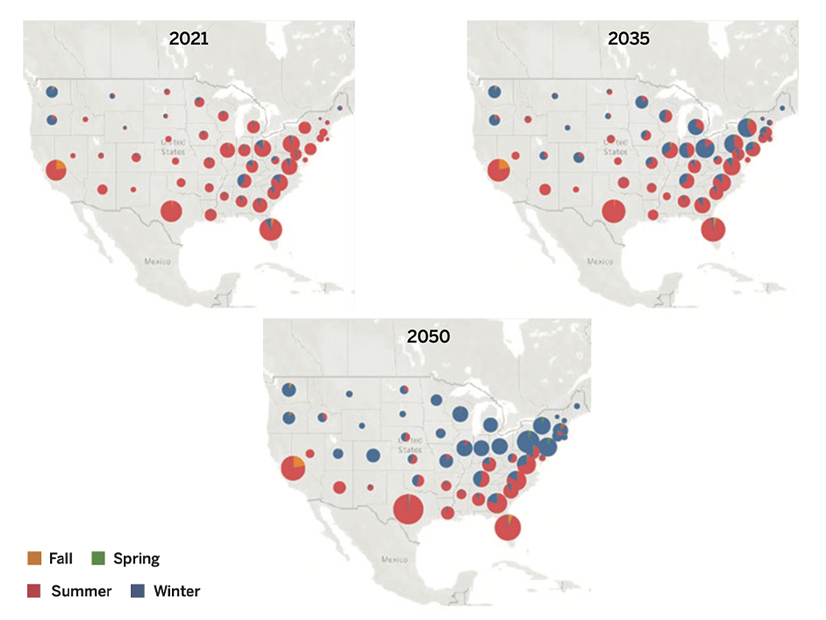
A new report argues that discussions about building electrification largely leave out one key issue: how to prepare the grid for the higher demand and new consumption patterns associated with the shift.
The Energy Systems Integration Group’s (ESIG) “Grid Planning for Building Electrification” report seeks to start that conversation, with a focus on the increasing share of home heating being served by the grid, which has the biggest impact on overall demand patterns.
“Building electrification gets a lot of attention in the industry, but little information is available about what grid planners should do about it today,” said Sean Morash, chair of ESIG’s Grid Planning for Building Electrification Task Force. “This report bridges the gap between building energy modelers and grid planners, providing insights that will shape the distribution and bulk power systems that support our energy transition.”
The effects of load growth on the distribution system are often only a minor consideration, but the long lead time and extended life of power infrastructure means that decisions today will support society into the 2060s, the report said.
“Load impacts from building electrification will increase the seasonality and weather dependence of loads, as well as increase the vulnerability of the power system to extreme weather, largely due to heating demand,” the report said.
Building electrification promises one major shift for the grid: as electricity is increasingly used for heating, many regions will shift from summer to winter peaks. Increased adoption of heat pumps, which tend to be more efficient than air conditioners, mean that summer peaks could decline in some regions. And while solar output aligns with gross peaks in the summer, winter peaks happen just before the sun comes up.
The report cites priority areas to improve distribution system planning in the face of growing electrification.
The first is to improve forecasting because the load shape impacts of building electrification will vary by location.
Areas such as the Southeast and Texas, where a lot of heating is already electrified, could see overall use decline as more energy-efficient heat pumps replace less efficient older units, or resistance heaters. But when it comes to winter peak demands for those states, cold snaps plus even more electrified homes could cause them to be higher.
“On the other hand, the adoption of electric heating in areas predominantly served with fossil fuels could result in a doubling of electricity use, affecting both peak power and total electricity needs,” the report said.
Distribution system planners will need a more granular understanding of technology adoption, such as the rates of electrification, what kinds of heat pumps are being adopted, and what that means for the local climate zone. Planners should also develop a solid baseline of current building demand broken down by end use because electrification will impact some significantly and others not at all.
Increased Winter Risk
Because electrification will make the grid more vulnerable to extreme temperatures, planners must consider extreme events, which includes factoring how climate change can impact those events over time, according to the report.
Traditional planning has centered around one peak demand event, but severe weather — especially in winter — can cause longer-duration stress by increasing loads for prolonged periods. Electrification of heating will exacerbate that stress, but it can be planned for by switching to a “time-series analysis” that assesses risk across multiple hours of the year and the efficacy of solutions for those intervals.
Distribution system equipment has some universal engineering standards, but local utilities embed their own assumptions about system conditions, demand diversity and load growth.
“However, past practices may not be well suited for electrification-driven load growth, which may have different hourly load impacts,” the report said. “Distribution system planners will need to reevaluate the underlying assumptions that drive equipment standards.”
The shift to longer-duration winter peaks can impact grid-edge equipment, which is typically designed to serve peak demands for short durations and can lead to component failures.
“Overload failures can occur throughout the grid, including in distribution systems, where equipment is often unmonitored,” the report said. “Grid failures during extreme winter weather events pose much more risk to human health and wellbeing than do summer peaks.”
The industry could avoid the largest impacts from electrification by relying more heavily on energy efficiency and demand management practices, the report said.
“In the context of building electrification, the most important energy efficiency measures are those that maintain building temperature with minimal input from the grid, because of the long duration of winter reliability events,” the report said.
Thirty percent of thermostats are “smart,” and actively tapping those and other demand resources can greatly help in reliably electrifying buildings, the report said.
To some extent, utilities can predict when some areas in their service territories are going to electrify because some programs target specific neighborhoods or are focused on low-income customers. They should then plan ahead and upgrade infrastructure with an eye to growing future demand.


